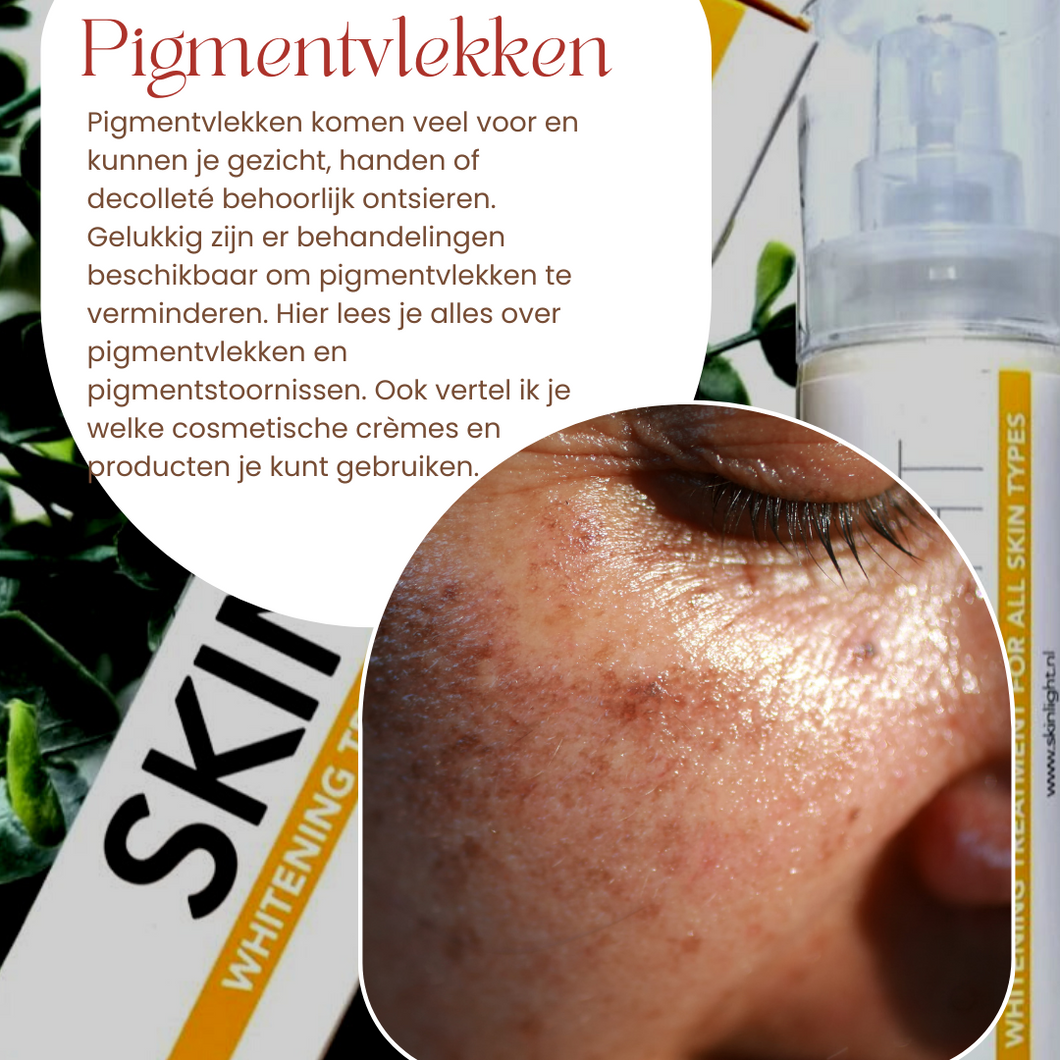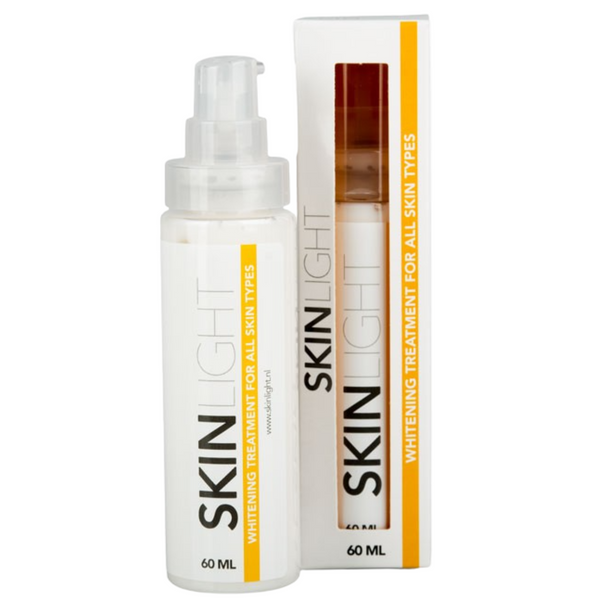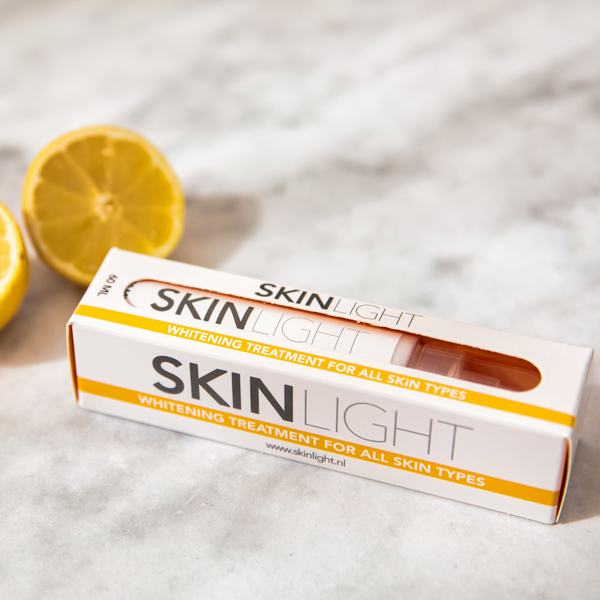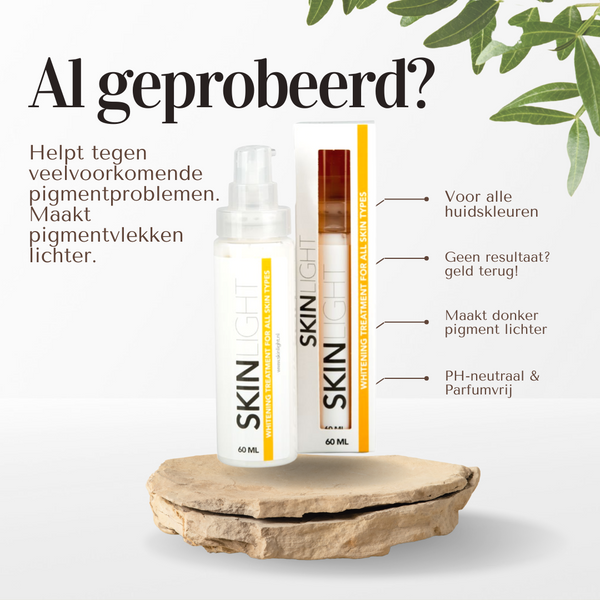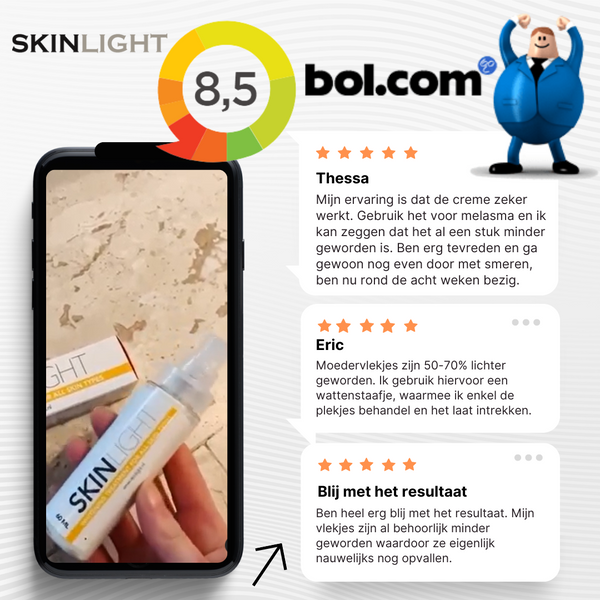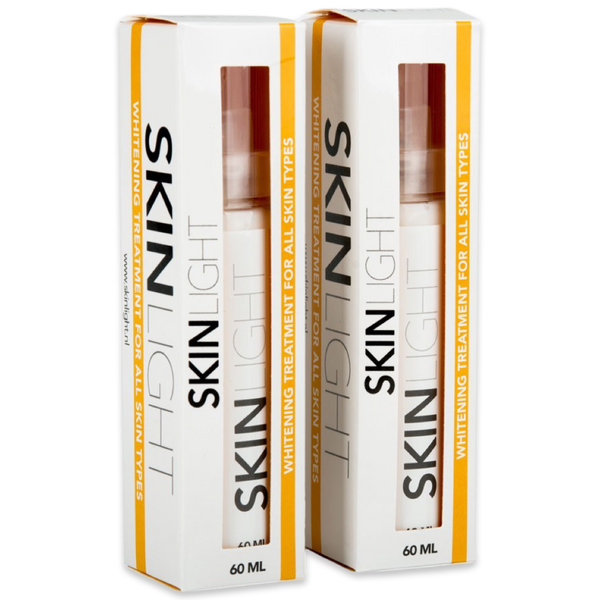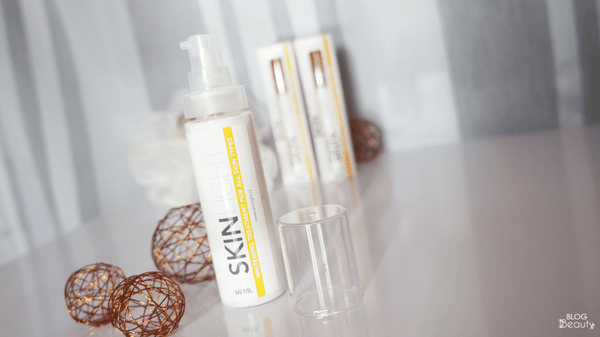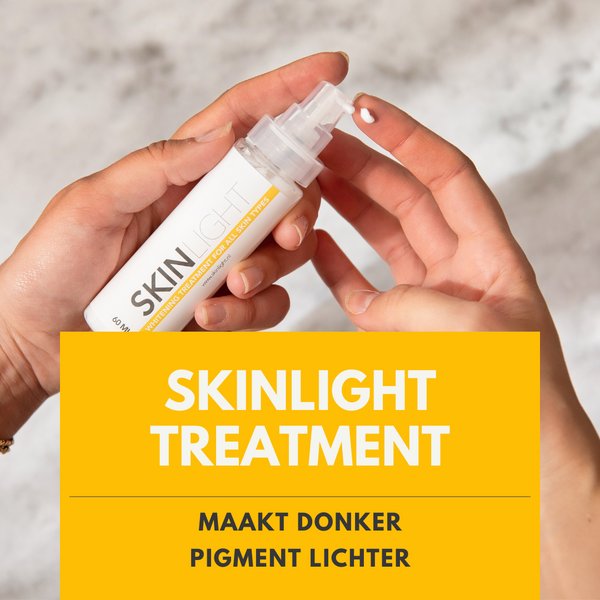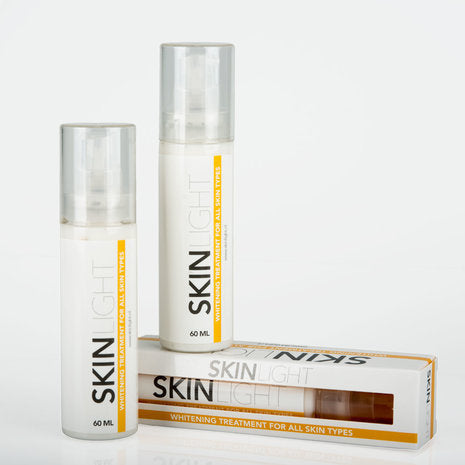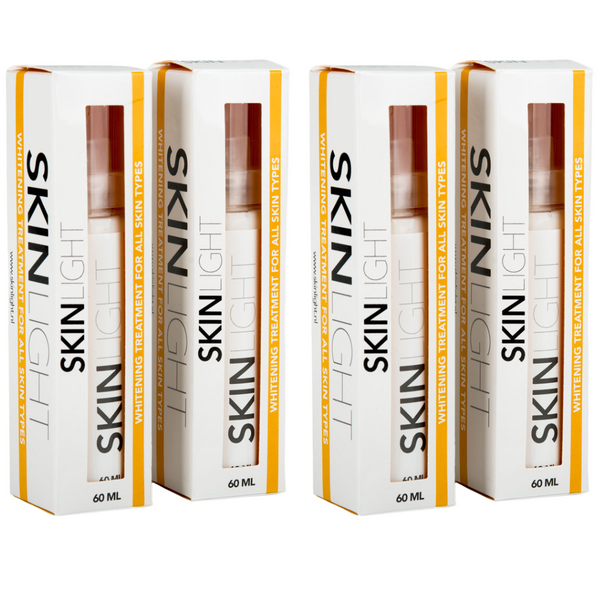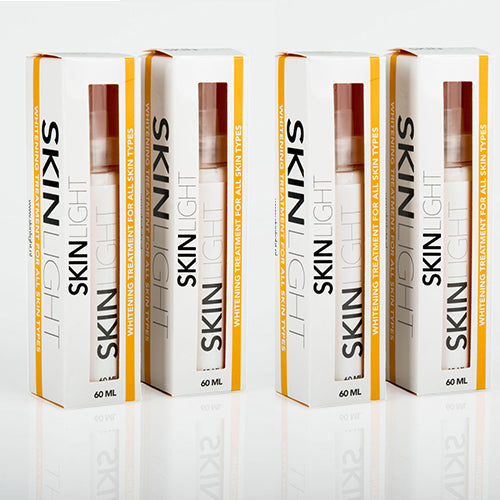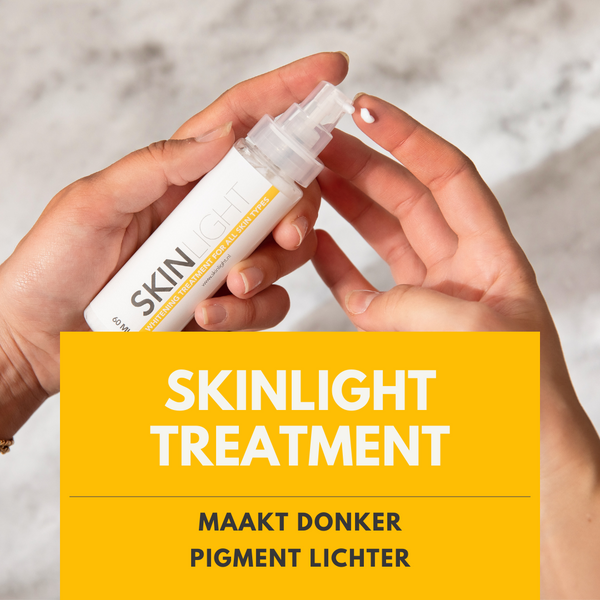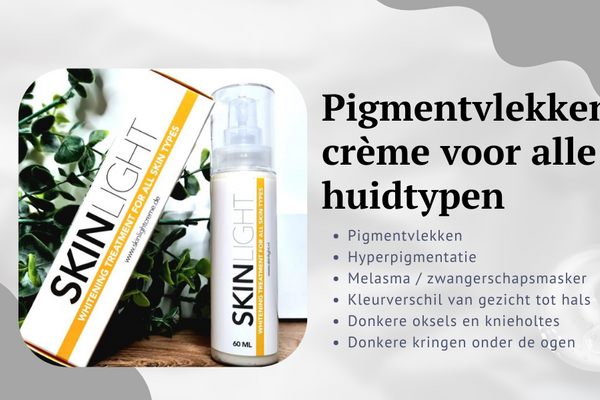Pigment spots are very common and can disfigure your face, hands or décolleté. Fortunately, treatments are available to reduce or remove pigmentation spots. In this article you can read all about the causes of pigment spots and the different types of pigment disorders. I will also tell you which cosmetic creams and products you can use to reduce pigmentation spots and which medication and treatments you can use in the clinic to remove pigmentation spots.
What are pigment spots?
Pigment spots are caused by the formation of pigment in the skin. Pigment is a brown substance (called melanin) that is produced by pigment cells under the influence of sunlight. The pigment cells are located in the lowest layer of the epidermis. If the cells receive the signal to produce pigment, this is delivered to the upper skin cells as a kind of package. When the packets of pigment reach the epidermal cells, the skin takes on a visible tan.
Pigment formation
Melanin, a brown substance, also known as pigment, is produced by pigment cells under the influence of mainly sunlight. This is a protective reaction of the skin against the sun's rays. The melanocytes, pigment cells, are located in the lowest layer of the epidermis. When the melanocytes receive the signal to produce pigment, it is sent as a kind of package to the upper skin cells. This process is triggered by exposure to sunlight. When the packets of pigment reach the epidermal cells, the skin takes on a tan.
Everyone has about the same number of pigment cells per skin area, regardless of whether you have light or dark skin. The color of the skin is determined by the activity of the pigment-forming cells and the size and shape of the pigment packets. In people with dark skin, the melanocytes contain more, larger and more mature pigment packets and the epidermal cells are fuller with pigment than in lighter skin types.
Pigment protects the skin from the sun. Under the influence of UV radiation, the number of active pigment cells and the production of pigment increase. This is why the skin turns brown when exposed to the sun.
What are the causes of pigment spots?
Under the influence of UV radiation, the number of active pigment cells and the production of pigment increase. But if this process is disrupted, melanin can accumulate and spots can appear. In addition to UV radiation, predisposition, hormonal changes, medicines and the use of irritating substances in cosmetics play a role in the development of pigment spots.
What different types of pigment spots are there?
There are different types of pigment disorders that can differ in shape, color, depth and cause. The most common pigment disorders are age spots/sun spots, melasma, irritation pigment, café au lait, freckles, freckles, poikiloderma of Civatte, vitiligo and Riehl's melanosis.
Age spots/sun spots
These are dark spots on the skin caused by sun exposure. They commonly appear on the face, hands, and décolleté. Age spots are a normal phenomenon of aging, as the skin becomes less able to protect itself against harmful UV rays as we age. Sunspots are caused by overexposure to the sun and can therefore also occur in younger people. They are characterized by a round or oval shape and are often dark brown in color.
Melasma: pigment spots due to pregnancy or the pill
These are brown spots on the skin caused by hormonal changes, such as during pregnancy. They occur mainly on the face and are often symmetrically distributed on the cheeks, forehead and chin. Melasma is also referred to as a pregnancy mask and may persist for some time after pregnancy. In addition to hormonal factors, genetic predisposition, exposure to the sun and the use of certain medications also play a role in the development of melasma.
Irritant Pigment (Post-Inflammatory Hyperpigmentation)
This is a dark discoloration of the skin that is caused by friction or irritation of the skin, for example by wearing tight clothing or using certain cosmetic products. It mainly occurs in areas where the skin often comes into contact with clothing, such as the neck, armpits and groin. The discolorations can vary in size and color and are sometimes somewhat thickened or scaly.
| Pigment spots caused by cosmetics and medication in the sun | Certain ingredients in cosmetics, such as fragrances and plant extracts or oils of citrus, orange, bergamot, mandarin, grapefruit, lavender and rosemary, can stimulate the formation of pigment spots when exposed to the sun. If you suffer from sudden pigmentation, it is wise to check the ingredients list of your cosmetics. |
| Some medications can also cause a skin reaction in the sun | This applies, for example, to certain antibiotics, antidepressants and water tablets. This information is always included in the package insert and ingredients list, so it is important to read it carefully. |
Coffee with milk
These are light brown spots on the skin that are present from birth and often enlarge with age. They are usually harmless and common in children and young adults. Although they usually do not cause any symptoms, they can sometimes be a sign of an underlying condition, such as neurofibromatosis.
Freckles
These are small brown spots on the skin that are caused by sun exposure and heredity. They mainly occur in people with a light skin type and are usually harmless. Although freckles are often seen as cute, there are also people who find them disturbing.
Summer freckles
These are small brown spots on the skin that are caused by exposure to the sun. They are often present on the nose, cheeks and forehead and disappear again in winter. Freckles are most common in fair-skinned people and are a sign that the skin has been overexposed to the sun.
Poikiloderma van Civatte
This is a skin condition in which red and brown discolorations occur in the neck and décolleté. The condition occurs mainly in women and is often caused by sun exposure and aging of the skin. The discolorations are usually symmetrically distributed and can vary in size and shape. Civatte's poikiloderma is harmless, but can be experienced as cosmetically disturbing.
Vitiligo
This is a condition in which the pigment cells in the skin are destroyed, causing white spots. The condition affects about 1% of the population and can develop at any age. Vitiligo can appear anywhere on the body and often has a major impact on the patient's quality of life. The cause of vitiligo is not yet fully understood, but an autoimmune reaction probably plays a role.
Riehl's melanosis
This is a skin condition in which dark brown spots appear on the skin of the face and neck. The condition occurs mainly in women and is often caused by sun exposure and the use of certain cosmetic products. The spots are usually symmetrically distributed and have an irregular shape. Riehl's melanosis is harmless, but can be experienced as cosmetically disturbing.
Dark circles and puffiness due to pigment
A dark discoloration under the eyes can be caused by blood vessels that show through thin(er) skin. But these 'circles' can also be the result of hyperpigmentation of the skin. Pigment deposition under the eyes is more common in people with a somewhat darker skin. This form of pigmentation is also very sensitive to sunlight; so rub it in well!
Useful tips
Make sure you always use a high SPF factor to protect yourself from the sun. Use at least SPF 30 to ensure sun protection. Also limit your visits to the tanning bed, as this can increase the risk of developing pigment spots.
Be careful with highly perfumed skin products if you plan to go out in the sun. Some perfume ingredients can cause irritation, which can lead to pigment spots.
Which creams and products help to reduce pigment spots?
Sunscreen: A sunscreen is the best cream to prevent and reduce pigment spots. Solar radiation plays a major role in most forms of overpigmentation. To prevent (more) pigment spots, it is important to protect yourself against the sun with a sunscreen that protects against UV-A and UV-B radiation and preferably contains antioxidants, such as the Suncare cream. It's never too late to start this. Without sun protection, treating pigment spots is pointless.
Products and ingredients that lighten pigment spots
There are ingredients in skin care products that have been proven effective in reducing pigment spots. For example, vitamin C, vitamin E a positive effect on the skin. Allantoin, an ingredient that exfoliates the skin, can reduce superficial pigment spots at a sufficiently high concentration.
3-O-Ethyl Ascorbic Acid (vitamine C)
3-O-Ethyl Ascorbic Acid is a stable, oil-soluble form of Vitamin C specifically formulated for the treatment of pigmentation spots. It has a powerful effect against the production of melanin, the pigment responsible for the appearance of pigment spots. Due to the inhibiting effect on melanin production, the formation of pigment spots is reduced and existing pigment spots can become lighter. In addition, 3-0-ethyl ascorbic acid also has an antioxidant effect and protects the skin against damage from free radicals and UV radiation. It can therefore help prevent further damage to the skin and reduce pigmentation.
Vitamin E
Vitamin E is a great ally for your skin! This powerful antioxidant protects your skin against harmful free radicals that are caused by, for example, exposure to UV radiation and air pollution. These free radicals damage your skin cells and accelerate the aging process, which can lead to pigment spots. Fortunately, vitamin E can prevent this damage by neutralizing free radicals and protecting your skin cells. In addition, vitamin E has anti-inflammatory properties that can help reduce inflammation that can cause pigmentation. With the help of vitamin E you can therefore reduce pigment spots and prevent further damage to your skin. Highly recommended!
Allantoin
Allantoin is a substance that occurs naturally in plants, such as comfrey and wheat germ. It has exfoliating, moisturizing, anti-inflammatory and skin-soothing properties. Allantoin can help reduce pigment spots by helping to renew and repair the skin. It stimulates cell growth and promotes the production of collagen and elastin in the skin, which improves the skin structure and makes pigment spots less visible. In addition, allantoin has a light exfoliating effect, which removes dead skin cells and makes the skin smoother. As a result, allantoin can contribute to healthy, radiant skin with fewer pigment spots.
Make-up for pigment spots
You can camouflage pigmentation spots with make-up. Use a concealer in combination with a foundation. A foundation evens out the skin and covers up imperfections, while a concealer is suitable for spots that require more coverage, such as pigmentation spots, scars or pimples. Choose a light cream that won't clog pores and comes in six shades. The concealer contains extra calming substances and is available in two colors.
Nutrition to prevent pigment spots
In addition to external care, you can also do something from the inside to prevent certain forms of pigment disorders. Antioxidant-rich food can help to (partly) protect your skin against damage caused by UV radiation. Recent research has shown that there is a link between the severity of melasma and the 'antioxidant level' in the body. It is therefore important to ensure that this is up to standard.Make sure to eat plenty of fruits and vegetables, such as bell peppers, broccoli, carrots, grapes, and berries. If this does not work, you can opt for supplements.
